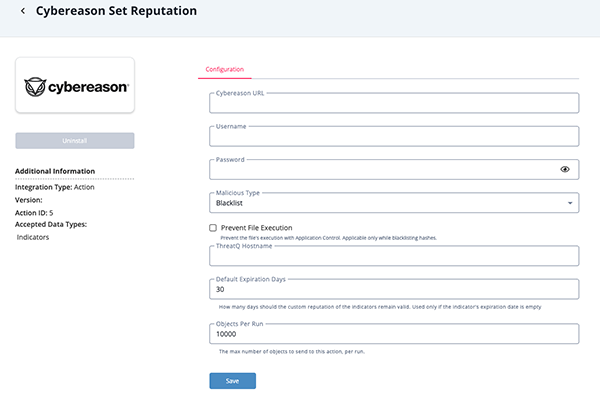Cybereason Action
The web format of this guide reflects the most current release. Guides for older iterations are available in PDF format.
Integration Details
ThreatQuotient provides the following details for this integration:
| Current Integration Version | 1.0.0 |
| Compatible with ThreatQ Versions | >= 5.26.0 |
| Compatible with Cybereason Versions | >= 21.2.101 |
| ThreatQ TQO License Required | Yes |
| Support Tier | ThreatQ Supported |
Introduction
The Cybereason Action enables users to set a custom, organization-specific reputation (whitelist or blacklist) for IoCs.
The integration provides the following action:
- Cybereason Set Reputation - set reputation for IoCs in the Cybereason platform.
The action is compatible with the following Indicator types:
- MD5
- FQDN
- IP Address
- SHA-1
This action is intended for use with ThreatQ TDR Orchestrator (TQO). An active TQO license is required for this feature.
Prerequisites
- An active ThreatQ TDR Orchestrator (TQO) license.
- A data collection containing at least one of the following indicator types:
- MD5
- FQDN
- IP Address
- SHA-1
- A Cybereason username and password.
Installation
Perform the following steps to install the integration:
The same steps can be used to upgrade the integration to a new version.
- Log into https://marketplace.threatq.com/.
- Locate and download the action zip file.
- Navigate to the integrations management page on your ThreatQ instance.
- Click on the Add New Integration button.
- Upload the action zip file using one of the following methods:
- Drag and drop the zip file into the dialog box
- Select Click to Browse to locate the zip file on your local machine
ThreatQ will inform you if the action already exists on the platform and will require user confirmation before proceeding. ThreatQ will also inform you if the new version of the action contains changes to the user configuration. The new user configurations will overwrite the existing ones for the action and will require user confirmation before proceeding.
You will still need to configure the action.
Configuration
ThreatQuotient does not issue API keys for third-party vendors. Contact the specific vendor to obtain API keys and other integration-related credentials.
To configure the integration:
- Navigate to your integrations management page in ThreatQ.
- Select the Actions option from the Category dropdown (optional).
- Click on the action entry to open its details page.
- Enter the following parameters under the Configuration tab:
The configurations set on this page will be used as the default settings when inserting this action into a new workflow. Updating the configurations on this page will not update any instances of this action that have already been deployed to a workflow. In that scenario, you must update the action’s configurations within the workflow itself.
Parameter Description Cybereason URL Enter your Cybereason instance URL. Username Enter your Cybereason username. Password Enter your Cybereason password. Malicious Type Select the type to set for IOCs. Options include Whitelist and Blacklist. Prevent File Execution Enable this parameter to prevent the file's execution with Application Control. This is only applicable when blacklisting hashes.
ThreatQ Hostname Enter your ThreatQ instance hostname or IP Address. This will be utilized when linking back to the ThreatQ instance.
Default Expiration Days Enter how many days should the custom reputation of the indicators remain valid. This option is only used if the indicator's expiration date is empty
Objects per Run Enter the max number of objects to submit per run.

- Review any additional settings, make any changes if needed, and click on Save.
Actions
The following action is available:
| Action | Description | Object Type | Object Subtype |
|---|---|---|---|
| Cybereason Set Reputation | Sets the reputation for IoCs in the Cybereason platform. | Indicator | MD5, FQDN, IP Address, SHA-1 |
Cybereason Set Reputation
The Cybereason Set Reputation action sets the reputation, whitelist or blacklist, for IoCs on the Cybereason platform.
This action does not ingest data back into the ThreatQ platform.
POST {{CYBEREASON_URL}}/rest/classification/update
Sample Request Parameters:
[
{
"comment": "Imported from ThreatQ: {{THREATQ_HOSTNAME}}/indicators/{{INDICATOR_ID}} Score: 4 Sources: Threat Quotient",
"expiration": 1709251200000,
"keys": [
"9a301f2a0259bdedb85e2ea4c071534776d471ab"
],
"maliciousType": "blacklist",
"prevent": true,
"remove": false
}
]Sample Response:
{
"outcome": "success",
"data": true
}Enriched Data
Object counts and action runtime are supplied as generalities only - objects returned by a provider can differ based on credential configurations and action runtime may vary based on system resources and load.
| Metric | Result |
|---|---|
| Run Time | 1 minute |
| Indicators | 50 |
Use Case Example
- A user identifies a group of MD5 and IP Addresses they want to set as Whitelisted on their Cybereason platform.
- The user creates a data collection that contains those objects.
- The user inserts that data collection into a workflow with the Cybereason action.
- The user selects the Whitelist option for the Malicious Type configuration parameter.
- The user saves and run the workflow.
Change Log
- Version 1.0.0
- Initial release
PDF Guides
| Document | ThreatQ Version |
|---|---|
| Cybereason Action Guide v1.0.0 | 5.26.0 or Greater |